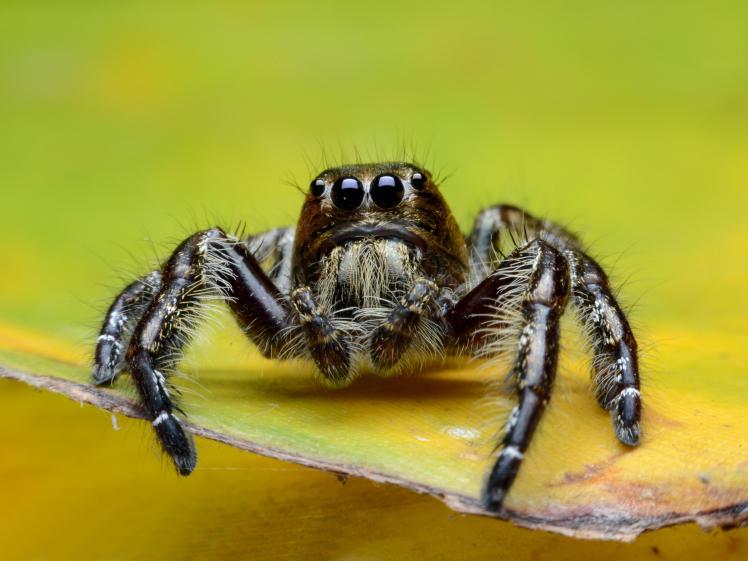 When it comes to virtual reality, do spiders get it? Why, yes they do. Not just relegated to thrilling the upper echelons of the food chain, the awesome fun of 3D printed otherworldly technology is, according to biologists at Macquarie University in Sydney, Australia, not lost on the arachnid world.
When it comes to virtual reality, do spiders get it? Why, yes they do. Not just relegated to thrilling the upper echelons of the food chain, the awesome fun of 3D printed otherworldly technology is, according to biologists at Macquarie University in Sydney, Australia, not lost on the arachnid world.
In an intricate test put together by biologists Tina Peckmezian and Phillip W. Taylor, spiders were gently manipulated into chilling, literally. After becoming relaxed due to a mild stint in refrigeration, the spiders were placed on a chilly granite block. In something bordering on both comedy and sci-fi, the creatures were then treated to quite the experiment after having tiny magnets attached to their bodies with an even tinier amount of glue.
Meant to facilitate the stimulating and fun (hey, even spiders have to live a little) experiment, the magnets allowed for the spiders to be lifted onto miniature, 3D printed treadmills where they were offered the opportunity to experience something so high-tech that many human beings have not yet even tried it out.
Held gently in place by the magnets, the spiders were able to stand on their 3D printed venues, in front of a video display, and check out their technologically enhanced surroundings. With the obvious lack of movement going on, as well as typical distractions found in nature like web-spinning and fly-catching, the captive audience was indeed accommodating in sharing neurological recordings as they walked through the VR program.
“I can appreciate that the idea of spiders wandering around through virtual space may sound like science fiction, but virtual reality technology has been an incredible tool in the behavioral and neurosciences,” said Peckmezian. “A common goal for animal behavior researchers is to find a middle ground between providing realistic, ecologically relevant experimental conditions [and] conditions that can be precisely controlled and reproduced across trials.”
The biologists came up with an entirely clever but completely simple test, allowing the spiders to traverse from their real world on the 3D printed platforms through the immersive VR setup, which was either marked with items that they could come back and forth to, or left blank. In triumph, the research showed that the spiders indeed were stimulated by and moved according to seeing pillars and beacons of light. They seemed to have memory recall from game to game if they had seen symbols previously, gravitating to them again.
Spiders placed in VR conditions with randomly placed symbols–or none at all–were not as active as the others, resulting in allowing the biologists to gather important research data and further study mediated cognition in invertebrates.
“Typically, there is a trade-off; you can test animals in their natural environment but can’t control the environmental variables present on a particular day; or you can present a series of automated stimuli, but these don’t provide important feedback information to the responding animal,” said Peckmezian. “VR lets you do both. You can create immersive, highly realistic 3D virtual environments that update in real time as the animal moves through them, and, since animals are typically restrained, can couple these with neurophysiological recordings.”
Jumping spiders are chosen because of their unique ocular setup, composed of four pairs of very specialized eyes that each bear its own, single lens. They are valuable subjects for this particular study because they are, like humans, capable of depth perception, seeing in color, and actually exhibit astonishing spatial sense, considering their eye-size.
 While the subject and technology are a perfect fit in research, 3D printing and VR show off their symbiotic relationship in this case as well–along with displaying how digital design is able to facilitate a project like this as the engineer can design a treadmill fit for a king–or a tiny creature showing off some mad skills for its size.
While the subject and technology are a perfect fit in research, 3D printing and VR show off their symbiotic relationship in this case as well–along with displaying how digital design is able to facilitate a project like this as the engineer can design a treadmill fit for a king–or a tiny creature showing off some mad skills for its size.
The researchers wrote a peer-reviewed paper on the topic, entitled ‘A virtual reality paradigm for the study of visually mediated behaviour and cognition in spiders.’
Are you interested in VR? Are you surprised that spiders were able to interact? Discuss in the 3D Printed Spider VR Treadmills forum over at 3DPB.com.
Subscribe to Our Email Newsletter
Stay up-to-date on all the latest news from the 3D printing industry and receive information and offers from third party vendors.
You May Also Like
3D Printing Unpeeled: New Arkema Material for HP, Saddle and Macro MEMS
A new Arkema material for MJF is said to reduce costs per part by up to 25% and have an 85% reusability ratio. HP 3D HR PA 12 S has been...
3D Printing News Briefs, January 20, 2024: FDM, LPBF, Underwater 3D Printer, Racing, & More
We’re starting off with a process certification in today’s 3D Printing News Briefs, and then moving on to research about solute trapping, laser powder bed fusion, and then moving on...
3D Printing Webinar and Event Roundup: December 3, 2023
We’ve got plenty of events and webinars coming up for you this week! Quickparts is having a Manufacturing Roadshow, America Makes is holding a Member Town Hall, Stratafest makes two...
Formnext 2023 Day Three: Slam Dunk
I’m high—high on trade show. I’ve met numerous new faces and reconnected with old friends, creating an absolutely wonderful atmosphere. The excitement is palpable over several emerging developments. The high...
































